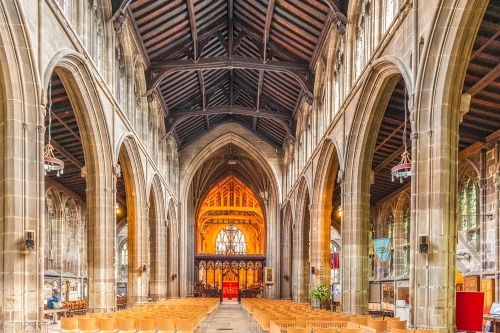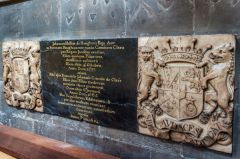
The origins of St Mary's Church are lost in the mists of time, but it seems likely that it was founded in the middle of the 7th century, when the settlement here formed part of the Kingdom of Mercia. The church was recorded in the Domesday Book of 1086. Nottingham at that time was a royal borough, and since St Mary's was the only church it had royal status.
That church was destroyed by fire in the 12th century and had to be rebuilt. The present church was begun in the 14th century and completed over 100 years later. Its size and spaciousness is a reflection of Nottingham's wealth in the later medieval period. Merchant guilds gave large sums of money to the church and established guild chapels within it.
The ornately carved south porch is rumoured to have been brought here at the Reformation from the Priory of Lenton. The vaulted porch was created around 1400.

As the largest building in Nottingham St Mary's had an important role in civic affairs and was used for the annual election of the Mayor. Services were traditionally held at St Mary's to begin each Mayor's official year in office. In 1412 a group of 49 burgesses gathered in St Mary's to elect a new Mayor. Their choice proved controversial and a riot ensued.
Interior features include gilded lion and unicorn sculptures dated to 1707, when England and Scotland were united into one country. The lion represents England and the unicorn represents Scotland.
Robin Hood at St Mary's
From history, we take a detour into legend. There are many stories associated with Robin Hood and his links to the city of Nottingham. One story dates to the 14th-century ballad called 'Robyn Hode and the Monk'. According to the ballad, Robin Hood came to St Mary's Church at Whitsuntide (the week that starts with Whit Sunday) to confess his sins, as was customary. He knelt before the rood screen at the east end of the nave. There he was recognised by a monk who he had recently robbed of £100.
The monk rushed to tell the Sheriff of Nottingham that he had 'spied the king's felon'. The Sheriff led a band of his men into the church to apprehend the outlaw. Robin killed several of the men and broke his sword over the Sheriff's head before he was taken and imprisoned in the town hall on High Pavement (where the Nottingham Contemporary Art Gallery now stands). But prison walls could not hold Robin Hood; he escaped with the aid of Little John and climbed over the city walls to freedom.

The Lace Bride
The Lady Chapel dates to the 15th century and is memorable for its beautiful stained glass windows. Four windows have fragments of medieval glass installed when the chapel was built. The east window is dedicated to Katherine Wade-Dalton, known as 'the Lace Bride'. She died in the Spanish influenza outbreak of 1918.
The stained glass depicts Katherine wearing a wedding dress made of Nottingham lace. She was baptised in St Mary's Church in 1899, married here on 23 October 1918 and died just seven days later. It is a tragic and poignant reminder of the terrible effects of the influenza outbreak that swept across much of the world in 1918/19. The window was designed by the famous Burlison and Grylls firm.
On the south wall of the Lady Chapel is a 15th-century tablet made of Nottingham alabaster. The tablet is sculpted with a bas-relief depicting a seated Pope inaugurating a bishop. The tablet was discovered lying face down under the choir stalls during restoration work in 1846. On the chapel wall is a terracotta maquette carved by George Timworth, depicting the Biblical tale of the Prodigal Son. The panel was exhibited at the Royal Academy in 1875.

Medieval Tombs
In the north transept is an ornate 15th-century tomb containing pieces from 3 separate memorials. The alabaster tomb beneath the canopy commemorates John de Tannesley, Bailiff and twice Mayor of Nottingham, who died in 1413. Tannesley was an Alderman of the Trinity Guild and was buried before the altar of the Chapel of St John, which was in the south transept. The tomb's canopy was added much later by Thomas Thurland (d. 1473), a church benefactor and another Alderman of the Trinity Guild. He also served twice as Mayor of Nottingham.
The marble slab inside the tomb niche is from the grave of William de Amyas (sometimes known as William de Mexborough), who founded the Chantry of St Lawrence in the south transept. De Amyas was a wealthy wool merchant, corn dealer, and ship owner who served four times as Mayor of Nottingham. He died sometime between 1348 and 1369. Preserved behind glass is a fragment of a tomb chest of Robert English, a wealthy merchant of Nottingham who died in 1475. His effigy lies in the north aisle.
Also in the south transept is a plaque commemorating John Hollies of Houghton, Earl of Clare (d. 1637). The original tomb was in such poor condition that it was removed in 1804. On the south wall of the transept is a large tomb niche built for the Samon family. The head of the family was John Samon, four times Mayor of Nottingham, who died in the early 15th century and is considered the main church benefactor.

The communion table in the north transept dates to the 17th century. Above it is a stained glass window by Clayton and Bell, installed in 1878 as a memorial to job Bradshaw.
The north aisle has a wealth of 17th and 18th-century memorials, including a wall tablet to Lady Mary Brabazon (d. 1715) and memorials to two brothers of the Cox family who each died at 16. On the wall is a tablet commemorating Lieutenant James Still of the HMS Pheasant, who died off Sierra Leone in 1821 where his ship was engaged in a battle against the slave trade.The font is 15th century, and is topped by a Victorian cover.
In the churchyard, you will find the grave of George Africanus, a former slave from West Africa who became a successful businessman in the late 18th and early 19th centuries. Africanus was Nottingham's first black citizen. He was born in Sierra Leone and brought to England by Benjamin Molyneux in Wolverhampton, who had him baptised, educated and trained as a brass founder.
He married a local woman and a son, also named George. All three are buried here. The original inscription on George senior's grave had become very worn by the early 21st century, so a new slate memorial was erected in 2007 to mark the bicentenary of the abolition of slavery.
St Mary's is a magnificent medieval building, full of historical interest. It is usually open to visitors and was open when we visited.
About Nottingham, St Mary's Church
Address: High Pavement,
Nottingham,
Nottinghamshire,
England, NG1 1HN
Attraction Type: Historic Church
Location: On High Pavement, near the Lace Market
Website: Nottingham, St Mary's Church
Location
map
OS: SK576396
Photo Credit: David Ross and Britain Express
HERITAGE
 We've 'tagged' this attraction information to help you find related historic attractions and learn more about major time periods mentioned.
We've 'tagged' this attraction information to help you find related historic attractions and learn more about major time periods mentioned.
Find other attractions tagged with:
NEARBY HISTORIC ATTRACTIONS
Heritage Rated from 1- 5 (low to exceptional) on historic interest
National Justice Museum - 0.1 miles (Museum) ![]()
Nottingham, St Peter's Church - 0.2 miles (Historic Church) ![]()
Nottingham Castle - 0.4 miles (Castle) ![]()
Robin Hood Statue - 0.4 miles (Historic Building) ![]()
Museum of Nottingham Life at Brewhouse Yard - 0.5 miles (Museum) ![]()
Wollaton Hall and Natural History Museum - 2.8 miles (Historic House) ![]()
Holme Pierrepont Hall - 3.2 miles (Historic House) ![]()
Strelley, All Saints Church - 4.6 miles (Historic Church) ![]()
Nearest Holiday Cottages to Nottingham, St Mary's Church:
Ilkeston, Derbyshire
Sleeps: 4
Stay from: £402 - 1241
More self catering near Nottingham, St Mary's Church












